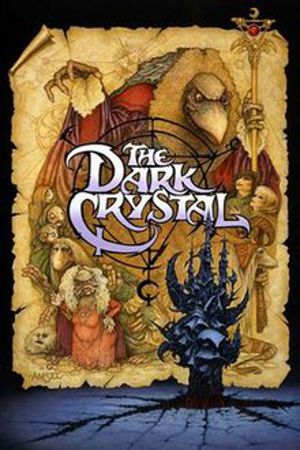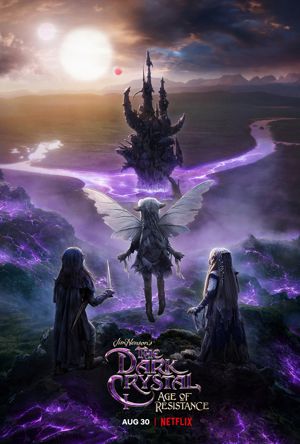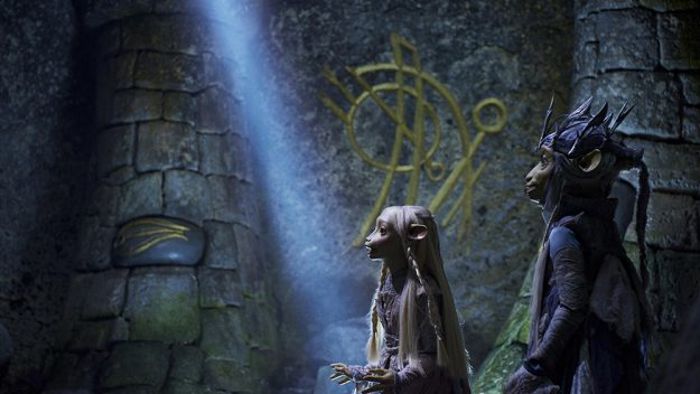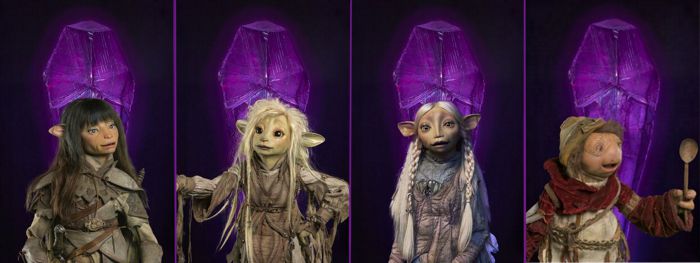The Dark Crystal: Age of Resistance – Thoughts

This was almost my entire childhood.
Good morning, Readers!
I grew up on The Dark Crystal. In my house, it shared a VCR tape with The Secret of NIMH. Or was it a Beta Max cassette? I can’t really remember, save that we had both players in the house. That’s not the point. The point is, I grew up watching The Dark Crystal. It was one of the favorite movies of my childhood. I remember being so invested in Jen and Kyra, terrified of the Garthim, and utterly petrified of the Chamberlain, whose terrible whimper became a signal for immediate danger.
I credit this movie for my love of all things dark fantasy, because it was incredibly dark. With the name Jim Henson attached, one might be forgiven in thinking it is a light, friendly tale designed for young children. While I would recommend it for children, as a matter of personal philosophy, The Muppets it is not. It is a dark story with frightening events that led to more than one nightmare (incidentally, having rewatched it as an adult, I found the story still excellent, the puppetry breathtaking, but the narration so thoroughly irritating. It’s still watchable for me, as long as I fast forward through the narration).
When I heard Netflix was “remaking” The Dark Crystal, my eyes rolled skywards and I cursed under my breath. Not only was The Dark Crystal perfectly fine as it is, but there are so many original stories, or even adaptations of original stories that deserve attention. Whhyyyyyyyyyyyyy must studios constantly remake things that already exist? I resolved to never watch it. Until I saw the trailer.

This is a spectacular poster, no? It’s so pretty.
The trailer got me. It got me really good. Suddenly, I was actually excited to see this, not least of all because it turns out that this “remake” is, in fact, not a remake at all. It’s a prequel. That’s far better than a remake, though it could also be disastrous (Star Wars, anyone?). Still, having been proven wrong about these kinds of things before (when I first heard they were making The Lord of the Rings in New Zealand, I rolled my eyes in derision hard enough to give myself a headache. I really should stop rolling my eyes), I decided to give it a go.
I watched eight of the ten episodes in one sitting.
It is genuinely beautiful. It has almost all of the elements of the original, except the fourth-wall-breaking looks directly to camera (Jen was terrible for that). There was absolutely still narration, but it was, thankfully, brief and not repetitive. The length and repetition of the narration in the original is what made it so damned irritating. I have to say, the fanfare from the original soundtrack that announced the series in the first episode made me well up with nostalgic love.
The puppetry is, as it was in the original, absolutely exceptional. Of course, this being the times in which we live, it was augmented with CGI. However, the CGI was not intrusive. The production seemed to have made sure that the puppetry was the crown jewel of the visuals in the series, including all the neat little movements of the tiny creatures populating the world that made the original feel so whole and real.
Scenery, too, was a visual feast. The matte paintings of the original were replaced with CGI, or at least so well done they appeared to have been thusly replaced. The world, as in the original, felt full, beautiful, and yet dangerous.

Mother and daughter in a secret chamber beneath their palace.
We get a great deal of lore in this series. It takes the time to show us gelfling society, setting up the world without the irritating exposition dump the original film suffered from. We also learn, without being told, that the crystal is already cracked when this story commences. It creates an excellent example of world-building done well.
The story itself is not subtle. It is absolutely a commentary on the environment and race relations. The skeksis represent the corrupt powers in our world, lying to the people about what is really happening while simultaneously being the cause of the problems facing Thra (their world). The people, believing the skeksis to be wise and benevolent, are not ready to see what the heroes of the resistance know to be the terrible truth. Sound familiar? Yeah.
Fortunately, the gelfling have something that humanity doesn’t: the ability to dreamfast. For the uninitiated, that simply means they can share their memories, bringing to light the truth the skeskis have been trying to hide by spreading misinformation, and branding the heroes as having an (infectious) illness of the brain. Sound familiar? Yeah. A few brave and curious souls ignore the warnings of the skeksis and, upon learning the truth, join the resistance. Others, however, cannot bring themselves to defy the skeksis, even when they learn the truth, applying some impressive mental gymnastics to pin the blame on the resistance. Sound familiar? Yeah.
Much also can be said of the gelfling clans themselves; how one clan, the Vapra, are the elite, and rule over the others simply by dint of their pedigree. When that is challenged, the order splinters and the new would-be high queen of Thra eschews tradition and outright claims the crown based on nothing but the fact that the Vapra were always the rulers. Only two of the leaders show courage enough to defy her, and walk away, joining the resistance. The rest fall in line, electing not to defy the skeksis. This strikes me as pertinent, even today, given how so many people have decided that they are above others for no other reason than their fortunate births.
Also, the Grottans are regarded by the rest of the gelfling clans as beneath them; their literal existence in the belly of the earth being used as the justification for their treatment. Sounds familiar, yeah?
In this imagining of the events that predate the original film, the unlikely band of gelflings from all corners of Thra for a resistance that is quite literally fighting for their world. They are fighting to keep their home alive, sometimes even having to fight their fellows in order to achieve their ends.
Despite how terribly unsubtle this all is, it still manages to be compelling. I’ve caught my breath a number of times in the episodes, screamed in alarm, and sobbed at the losses. Despite being a ham-handed thing, I’ve been drawn in.
We can thank the beautiful scenery, the puppetry, and the acting for that. But also, the writing and, most importantly, the characters.

The main(ish) heroes: Rian, Deet, Brea and Deet’s faithful podling, Hup.
It’s a well known fact amongst my friends and acquaintances that a story can be the best in the world, but if the characters are dull, I get bored. I love these characters. It was interesting to me to see gelflings with weapons (even if the limitations of puppetry means that they’re not all that proficient with them). Rian begins his journey as a guard in the Castle of the Crystal, son of the Captain of the Guard. As such, he is, one imagines, quite familiar with weapons (also due to the fact that he belongs to the Stonewood Clan). He is earnest, as all gelfling seem to be, and brave. Deet, of the Grottan Clan, is sweet and gentle, a sort-of earth maiden type, with knowledge of healing and kinship with the creatures of Thra. Brea is a princess of the Vapra Clan, who spends her time buried in books in the library (a mood, honestly), curious about the world in which she lives. It’s this curiosity that lands her in trouble. Hup is the noble-hearted podling who attaches himself to Deet. No one could question his courage, nor his skill with a spoon.
I really appreciate, however, that the gelflings are not all one note in this. Some of them are greedy or malicious (even if only mildly). Some of them are embittered, or utterly misguided, or even just racist, and that darkens their hearts against their own. Some manage redemption. Some are lost to the darkness of their hearts. The character arc of one of Brea’s sisters is especially fascinating, and gives the gelfling as a people the depth they lacked in the original. I mean, there were only two in the original, so that cannot be a surprise.
Other gelfling heroes worth noting are Ordon, whose love for his son supersedes his duty as Captain of the Castle Guard, Tavra, who is caught often mediating between Brea and their elder sister, Gurjin, Rian’s friend who aids his escape, and defiant Rek’yr, who is unafraid of death.
The villains, too, were wonderful, and not all of them were skeksis. Honestly, the writers did a brilliant job of making the world and the people inhabiting it complex and fascinating, making some of the more ham-handed aspects of the story entirely believable.
I have yet to finish the series. The last two episodes remain unwatched. I have a good excuse… sort of. The first is that I cried so much during the first eight that I need to recover my strength to watch the last two, especially since I know that this particular story of resistance does not end well for our heroes. Anyone who has watched the original will know this (I say that’s the first. It is the greatest reason I have). I also don’t want this story to end. I have loved returning to Thra so much, I have loved the characters and cherished their courage so deeply, that having it end is not something I’m rushing towards.
While there are moments of wonderful levity, this series is as dark as the original, and I love that about this. They didn’t tone down the horror of the story, as surely must have been the temptation. The darkness is necessary to the story, I think. I’m glad they kept it dark.
Honestly, I adore this series. I did not expect to love this prequel series nearly as much as I do, but I do love it. As far as productions leeching off nostalgia in order to get made, this is one that I think did it right.
What about you? Have you watched it? What did you think?
When S.M. Carrière isn’t brutally killing your favorite characters, she spends her time teaching martial arts, live streaming video games, and cuddling her cats. In other words, she spends her time teaching others to kill, streaming her digital kills, and cuddling furry murderers. Her most recent titles include ‘Daughters of Britain’ and ‘Skylark.’ www.smcarriere.com
I rewatched the original Magic Crystal for the first time in decades just a few months ago and found it almost unwatchable. But then my childhood was long gone by the time the movie came around, and I think that makes a difference (though I’ve always loved the Secret of NIMH). The whole era was, for me at least, a wasteland – Willow (thinking of it even now gives me the dry heaves), Krull (please, God, no), Ladyhawke (cinematic waterboarding)…and those are the high points!
That said, I may well watch this Magic Crystal iteration. Netflix is worse than crack.
It certainly helped that I was a youngin’ when I watched it. The nostalgia mitigates some of the rougher parts. I haven’t seen Krull, so can’t speak to it, and I found Willow amusing though not cinematic excellence by any stretch.
Ladyhawke has a brilliant premise, really, and could do with a remake. It’s one of the few remakes I’d actually watch.
I, too, gew up with “Dark Crystal” being in the primary rotation of movies I watched–right alongside Fritz Lang’s “Metropolis” and the Marx Brothers’ “Animal Crackers” (which probably says a lot about me), but I wasn’t not skeptical of the reboot, it being a prequel and all.
Suffice it to say, I think the Henson people (with Netflix cash) did a great job building a back-story grand enough to live up to the narrative established in the movie. More-so, I’m looking forward to the next bit of the story which, if made, would likely be aptly called “Dark Crystal: the Age of Genocide”. While the recent television series has a happy ending (for all intents and purposes), the gap between its finishing point and the film’s starting point will doubtless be ceaselessly bleak. (And that is not a problem.)
(I hope it’s not poor form, but provided is a link to my review of the Netflix series: https://366weirdmovies.com/capsule-the-dark-crystal-age-of-resistance-2019/)
Cheers.